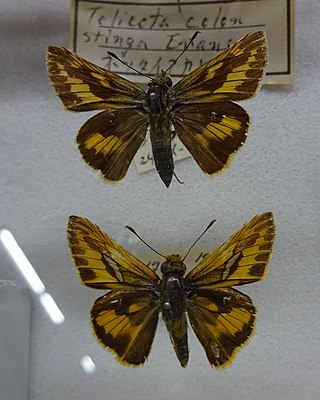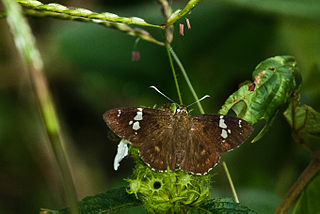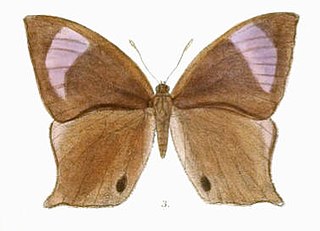
Leptosia nina, the psyche, is a small butterfly of the family Pieridae and is found in Indian subcontinent, southeast Asia and Australia. The upper forewing has a black spot on a mainly white background. The flight is weak and erratic and the body of the butterfly bobs up and down as it beats its wings. They fly low over the grass and the butterfly rarely leaves the ground level.

Arnetta vindhiana, the Vindhyan bob, is a species of butterfly belonging to the family Hesperiidae. It is native to India.

Halpe homolea, the Indian ace or Ceylon ace, is a butterfly belonging to the family Hesperiidae.

Taractrocera ceramas, commonly known as the Tamil grass dart, is a butterfly belonging to the family Hesperiidae. It is found from the Western Ghats to Mumbai, in the hills of southern India, in northeast India to northern Burma and in south-eastern China.

Telicota colon, commonly known as the pale palm dart or common palm dart, is a butterfly belonging to the family Hesperiidae found in India to Australia.

Thoressa astigmata, the southern spotted ace, is a butterfly belonging to the family Hesperiidae. The species was first described by Charles Swinhoe in 1890. It is endemic to the Western Ghats of India and is found in the states of Kerala, Tamil Nadu and Karnataka.

Thoressa sitala, the Tamil ace or Sitala ace, is a butterfly belonging to the family Hesperiidae found in south India.<

Abaratha ransonnetii, commonly known as the golden angle, is a butterfly belonging to the family Hesperiidae. It was first described by Baron Cajetan von Felder in 1868.

Abaratha alida, the yellow spotted angle or Alida angle, is a butterfly belonging to the family Hesperiidae. It is found in India, Sri Lanka, Myanmar, Thailand, Vietnam, Laos, Hainan and southern China. It was first described by Lionel de Nicéville in 1891.

Celaenorrhinus ruficornis, commonly known as the Tamil spotted flat, is a species of butterfly belonging to the family Hesperiidae which is found in India, Java, and the Sulawesi Region.

Hyarotis microstictum, the brush flitter, is a butterfly belonging to the family Hesperiidae. It is found in the Indomalayan realm and in South India. H. m. coorga Evans, 1949 is the subspecies found in South India. H. m. microstictum is the subspecies found in the Indomalayan realm.

Curetis thetis, the Indian sunbeam, is a species of lycaenid or red butterfly found in Indomalayan realm.

Chilades lajus, the lime blue, is a small butterfly found in India, Sri Lanka, Myanmar, Taiwan, Hong Kong, Hainan, Mangulam Island, Sulawesi and the Philippines that belongs to the lycaenids or blues family.

Anthene emolus, the ciliate blue, is a small butterfly found in India and southeast Asia that belongs to the lycaenids or blues family. The species was first described by Jean-Baptiste Godart in 1823.

Parantirrhoea is a monotypic butterfly genus in the family Nymphalidae. Its only species, Parantirrhoea marshalli, the Tranvancore evening brown, is endemic to the Western Ghats of India. James Wood-Mason described this species from the specimens in the collection of G F L Marshall which were collected by Harold S. Ferguson who was director of the State Museum at Trivandrum. Little was known about the species in the wild until a population was discovered in the Periyar Tiger Reserve in 1993. Sightings of both sexes of this butterfly are reported in the southern region of the Western Ghats in 2002. In 2006, larvae were collected from an Etah jungle like habitat in Kallar-Ponmudi valley, a northerly extension of the Ashambu hills of southern Western Ghats. Caterpillars collected were reared in laboratory conditions. It is also known from Periyambadi in Kodagu.

Ypthima huebneri, the common fourring, is a species of Satyrinae butterfly found in Asia.

Ancema blanka, the silver royal, is a species of lycaenid or blue butterfly found in the Indomalayan realm. The species was first described by Lionel de Nicéville in 1894.

Hasora anura, the slate awl, is a species of hesperid butterfly found in Asia. In India it is found in Sikkim and the Khasi Hills.

Thoressa honorei, commonly known as the Madras ace, is a skipper butterfly belonging to the family Hesperiidae found in south India.

Celaenorrhinus putra, commonly known as the Bengal spotted flat, is a species of butterfly in the family Hesperiidae. It is found in India and south-east Asia.




















